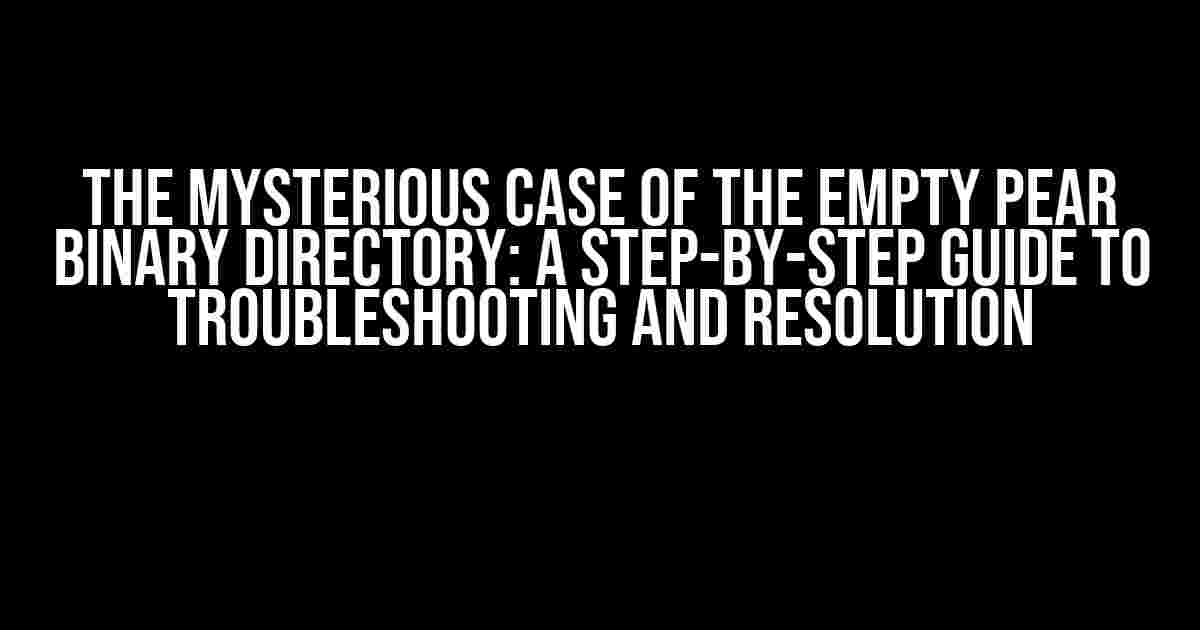Are you facing the frustrating issue of an empty PEAR binary directory? Don’t worry, you’re not alone! In this article, we’ll delve into the possible causes and provide a comprehensive guide to help you troubleshoot and resolve this pesky problem.
What is the PEAR Binary Directory?
Before we dive into the solution, let’s quickly cover the basics. The PEAR (PHP Extension and Application Repository) binary directory is a crucial component of the PHP framework. It stores the compiled binary files for PHP extensions, which are essential for running various applications and scripts. The PEAR binary directory is usually located at /usr/lib/php5/pear or C:\php\pear, depending on your operating system.
Symptoms of an Empty PEAR Binary Directory
If your PEAR binary directory is empty, you might encounter the following symptoms:
- Error messages indicating that PHP extensions are missing or not found
- Fatal errors or warnings during script execution
- Inability to install or update PHP extensions using PEAR
- Broken or malfunctioning applications and scripts
Possible Causes of an Empty PEAR Binary Directory
There are several reasons why your PEAR binary directory might be empty. Here are some possible causes:
- PEAR installation issues: Incorrect or incomplete installation of PEAR can lead to an empty binary directory.
- Permission problems: Insufficient permissions or incorrect ownership can prevent PEAR from writing to the binary directory.
- Corrupted or missing files: Damaged or missing files in the PEAR installation can cause the binary directory to be empty.
- Incorrect configuration: Misconfigured PHP or PEAR settings can prevent the binary directory from being populated.
Troubleshooting Steps
Now that we’ve covered the possible causes, let’s move on to the troubleshooting steps:
Step 1: Verify PEAR Installation
Check if PEAR is correctly installed by running the following command in your terminal or command prompt:
pear versionIf PEAR is not installed, you can download and install it from the official PHP website.
Step 2: Check Permissions
Verify that the PEAR binary directory has the correct permissions. You can do this by running:
chmod 755 /usr/lib/php5/pear (for Linux/macOS)icacls C:\php\pear /grant:r Everyone:F (for Windows)Replace the directory path with your actual PEAR binary directory.
Step 3: Rebuild the PEAR Binary Directory
Try rebuilding the PEAR binary directory by running:
pear clear-cachepear update-channelspear upgrade pearThis will clear the cache, update the channels, and upgrade PEAR to the latest version.
Step 4: Check PHP Configuration
Verify that your PHP configuration is correct. Check the php.ini file for any incorrect or missing settings. Specifically, look for the following:
; extension_dir = "/usr/lib/php5/pear" (for Linux/macOS)
; extension_dir = "C:\php\pear" (for Windows)Make sure the extension directory is correctly set and uncommented.
Step 5: Reinstall PEAR Packages
If the above steps don’t resolve the issue, try reinstalling the PEAR packages. You can do this by running:
pear uninstall pearpear install pearThis will completely remove and reinstall PEAR and its packages.
Resolving the Issue: A Step-by-Step Guide
Now that we’ve covered the troubleshooting steps, let’s provide a comprehensive guide to resolving the issue:
| Step | Action | Command |
|---|---|---|
| 1 | Verify PEAR installation | pear version |
| 2 | Check permissions | chmod 755 /usr/lib/php5/pear (for Linux/macOS) or icacls C:\php\pear /grant:r Everyone:F (for Windows) |
| 3 | Rebuild the PEAR binary directory | pear clear-cache, pear update-channels, and pear upgrade pear |
| 4 | Check PHP configuration | Verify php.ini settings for correct extension directory |
| 5 | Reinstall PEAR packages | pear uninstall pear and pear install pear |
Conclusion
In conclusion, an empty PEAR binary directory can be a frustrating issue, but with the right troubleshooting steps and resolution guide, you can easily resolve the problem. Remember to always verify PEAR installation, check permissions, rebuild the PEAR binary directory, check PHP configuration, and reinstall PEAR packages if necessary. By following these steps, you’ll be able to overcome the “PEAR binary directory is empty” issue and get your PHP applications and scripts running smoothly.
Don’t forget to regularly update your PEAR packages and maintain a clean and optimized PHP environment to avoid similar issues in the future.
Frequently Asked Question
Stuck with the “PEAR binary directory is empty” error? Don’t worry, we’ve got you covered!
What does “PEAR binary directory is empty” mean?
This error occurs when the PEAR (PHP Extension and Application Repository) installer can’t find the necessary files in the binary directory. It’s like searching for a needle in a haystack, but the haystack is empty!
How do I fix the “PEAR binary directory is empty” error?
Easy peasy! Simply download the PEAR installer and reinstall it. This should fix the issue and populate the binary directory with the necessary files. Think of it as reinstalling a fresh copy of the haystack, complete with the needle!
What if I’m still getting the error after reinstalling PEAR?
In that case, try checking the permissions of the binary directory and its contents. Make sure the installer has the necessary access rights to populate the directory. It’s like giving the installer the right keys to unlock the haystack!
Can I use a different package manager instead of PEAR?
Yes, you can use alternative package managers like Composer or PHAR. They might be more suitable for your project’s needs, and who knows, you might find them more convenient to use than PEAR! It’s like switching to a different type of haystack, one that’s more to your liking!
How do I prevent the “PEAR binary directory is empty” error in the future?
A great question! To avoid this error in the future, make sure to regularly update your PEAR installation and keep your system clean and organized. Think of it as regularly tidying up your haystack, so the needle is always easy to find!
